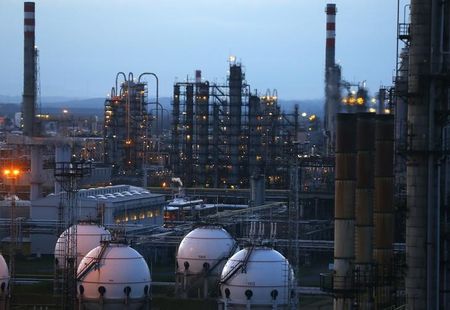Commodities
Oil prices steady after China-inspired weakness; OPEC+ in tricky place

Investing.com– Oil prices steadied Wednesday, with traders digesting progress towards an Israel-Hamas ceasefire as well as continued concerns over demand growth in China, the world’s largest importer..
At 09:00 ET (13:00 GMT), gained 0.5% to $77.57 a barrel, while rose 0.5% to $73.52 a barrel.
Israel agrees to preliminary ceasefire deal
Media reports earlier this week indicated Israel had agreed to a preliminary ceasefire deal brought on by the U.S., although the details of the agreement were still to be negotiated.
But Hamas was reported to be critical of the new deal, and that it reflected an American bias towards Israel. Hamas also issued a statement criticizing U.S. President Joe Biden.
Hamas’ comments came as Israel continued its offensive against Gaza, which further complicated the prospect of a ceasefire.
The Israel-Hamas war has been a key point of contention for oil markets, amid persistent concerns that a spillover in the conflict could disrupt oil supplies in the Middle East.
U.S. Secretary of State Antony Blinken was seen shuttling between Egypt, Qatar and Israel earlier this week to broker a ceasefire. But no deal appeared to be reached so far.
OPEC+ in “difficult situation” – ING
Crude prices have suffered steep losses in recent sessions on persistent concerns over slowing demand in top importer China.
Since peaking above $82 on Monday last week, had shed 6.2% of its value by the end of trading on Tuesday, while the Nymex contract has dropped 7.5% in the same period.
“While weaker Chinese demand has been well reported, refinery margins around the globe have been under pressure for much of August, suggesting that these demand concerns are not isolated to just China,” said analysts at ING, in a note.
“The weakness in the oil market leaves OPEC+ in a difficult situation,” ING added.
“Currently, they are set to start gradually unwinding supply cuts from October. However, the negative sentiment in the market may make the group think twice about sticking to this plan. Unfortunately for OPEC+, the global oil balance is set to be looser next year, suggesting that plans to ease cuts through 2025 may also have to be revisited.”
US inventories see small build – API
Data from the showed that U.S. inventories grew nearly 0.4 million barrels in the week to Aug. 16, against expectations for a draw of 2.8 million barrels.
The API data usually heralds a similar reading from , which is due later on Wednesday, and spurred some concerns that U.S. demand was cooling as the travel-heavy summer season came to a close.
Data from the showed U.S. inventories grew for the first time in nine weeks earlier in August, with smaller draws in gasoline and distillate inventories furthering the notion that demand was cooling.
U.S. oil production recently hit record highs, furthering concerns of oversupplied oil markets.
(Ambar Warrick contributed to this article.)
Commodities
Oil prices rise; U.S. crude inventories plunge, Russia-Ukraine truce eyed
Commodities
India’s Reliance to stop buying Venezuelan oil over US tariffs, sources say
Commodities
Oil prices climb on Venezuela supply worries

 Forex3 years ago
Forex3 years agoForex Today: the dollar is gaining strength amid gloomy sentiment at the start of the Fed’s week

 Forex3 years ago
Forex3 years agoUnbiased review of Pocket Option broker

 Forex3 years ago
Forex3 years agoDollar to pound sterling exchange rate today: Pound plummeted to its lowest since 1985

 Forex3 years ago
Forex3 years agoHow is the Australian dollar doing today?

 Cryptocurrency3 years ago
Cryptocurrency3 years agoWhat happened in the crypto market – current events today

 World3 years ago
World3 years agoWhy are modern video games an art form?

 Commodities3 years ago
Commodities3 years agoCopper continues to fall in price on expectations of lower demand in China

 Economy3 years ago
Economy3 years agoCrude oil tankers double in price due to EU anti-Russian sanctions



























